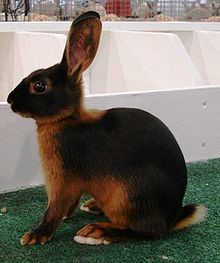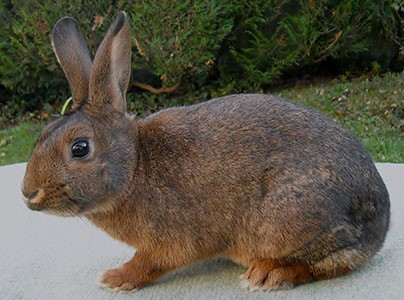Scientific Facts
| Common Name: | Brown Chestnut of Lorraine |
| Size: | Small |
| Country of Origin: | France |
History
These species were born in a serene and green locality. They were timidly and minimally propagated. It is, nevertheless, essential to give devotion to the one who created them – M. Ch. KAUFFMANN – to be aware, despite that, to stay loyal to his standard and race.
Mr. Ch. KAUFFMANN lived in Vitry-sur-Orne, a little region immersed in the Lorraine steel valley “SIDELOR” the whole time. It was during the last part of a selection work taking 4 years from 1921 up to 1925, and originating from an output of various intersection between the Black Fire and the wild rabbit that he managed to acquire the original copies and again in minimal volumes. He presented them for the very first time, the same period, during the International Exhibition of Metz, where these races were evaluated by the assigned people and judges who are part of the Union of Poultry Judges Bas-Rhin, Haut –Rhin and the Moselle, who rendered them approving feedback.

Physical Description
The general color looking similar to a chestnut brown, the creator of these species had given them the name “Brown Chestnut of Lorraine.” These species are thus outputs of various crossings that took place between the Black Fire and the wild rabbit. They have a superior quality of meat, and they have impenetrable fur.
The Brown Chestnut of Lorraine is a domestic breed of rabbit that first came from France. This rabbit is also popular in the name Brun Marron de Lorraine. This breed is currently treated peculiar. Its ideal weight is around 22.4 kilograms. It is a small animal with fur that has a shade of chestnut brown and is composed of layers of various shades.
The Brown Chestnut of Lorraine is being illustrated as a little and slim rabbit that is gracefully rounded. They have a crooked head with extrusive eyes. They have bluish ears that are positioned on the inner portion and bordered with a black margin.
Lifespan
The lifespan of the Brown Chestnut of Lorraine rabbits would depend on the quality of care given to them by their owners. Unlike the wild rabbits, these creatures are raised with comparable comfort. They are given their required diet, shelter, and warmth. This is the very reason why they are assumed not to last long when placed in the wild.
Owners of Brown Chestnut of Lorraine rabbits should know their responsibilities in raising these creatures. These cure animals are worthy of proper care. If they get a kind of care that is quality and appropriate, then there is a better chance for these creatures to live longer than expected.

Eating Habits
Brown Chestnut of Lorraine rabbits is a typical herbivore. Their diet would differ depending on the current season. When the season is cold, you would see these cute creatures consuming on woody shots, green vegetation, buds, conifer needles, and tree bark. During the summer and spring seasons, they would normally put a lot of concentration on flowers, clovers, grass, and crops.
Just like other kinds of rabbits, these creatures are known to be picky eaters. They are commonly more inclined about eating foliage instead of stems. If given a choice between dry plants and new plants, they will certainly choose the latter. Rabbits feed more protein and minimal fiber if all available plant nourishment is being considered.
For most situations, rabbits eat early in the morning during daybreak and feed again right at the start of the evening.
Sleeping Habits
Being prey animals, Brown Chestnut of Lorraine is always exposed to the risk of becoming a snack of a predator. You would notice that even though your pet is already placed in a safe place, your rabbit is always attentive to the predators that could eat him. To help your pet get enough and sufficient sleep, place him in a safe place that is far from noise and give him a lot of convenient bedding.
Rabbits are naturally day sleepers. They are highly active during dawn and dusk. This would give you an explanation of why rabbit owners are suggested to interact with their rabbits during the early evening or early morning. Your rabbit may sleep upright. If it gets relaxed and snoozing, you will see your pet lay either sideways or in its stomach, which the rear legs extended out.

Development and Reproduction
Brown Chestnut of Lorraine rabbits become sexually mature once they reach 4 to 4.5 months. Just like the other animals, the release of eggs in females is brought through sexual interaction. Pregnancy commonly lasts around 31 to 33 days. If the female rabbit has failed to give birth on the day 32 of her pregnancy period, there is a possibility that your veterinarian will opt to induce labor. There are times that the pregnant rabbit will resorb or abort the fetuses because of a disease or nutritional deficiencies.
Counting 28 to 29 days after the breeding, nest boxes must be placed in the cage. If the nest boxes are placed too early, they will become stinky with feces and urine. One day before the giving of birth, the doe will pull fur coming from the body and creates a nest in the nest box.
How to Breed
Determining the Sexes
Sexing your Brown Chestnut of Lorraine rabbit is important, especially if you are planning to breed. The surest way of determining the sex of your rabbit is to check its organ. Male rabbits have a penis that occurs as a tubular projection. Females, on the other hand, is observed with a pink bulge, but the projection is oblique, more oval, and exhibits a slit versus a little round opening.
Courtship and Mating
The mating habits of the Brown Chestnut of Lorraine rabbits can be disturbing. During mating, the male may sniff the anogenital portion. The female may also the same thing. After sniffing, they may take some time to stay still. Once the male marks the female, he will chase around the female. If the female is responsive, she will encourage the male to mount by lying down. However, if the female is not responsive, she may escape from the male or even demonstrate invasion. In the last movement, the male will ejaculate and emanate a noise.
Common Health Problems
Rabbits are susceptible to many health issues. Some affections and illnesses are more seemingly to occur than others; hence, it would be beneficial to know and understand what they are as well as their indications and manifestations to treat or prevent them. Brown Chestnut of Lorraine rabbits may suffer from ear mites, overgrown teeth, abscesses, hairballs, and bumblefoot.
Preventing Illnesses
You can prevent your rabbit from getting ill by providing it proper nourishment and appropriate care. Knowing that these creatures are susceptible to illness, it also pays that you monitor the behavior of your pet. If you think that something is not normal in your rabbit or thinks that it is sick, it would be best if you immediately consult a veterinarian.
Behavior
Rabbits are comical creatures. They are not noisy. There are times that these creatures get mad and would do granting. They are animals of habit, and once they do things rightfully, they would prefer to keep these things the same.
Habitat
Enclosure
Make sure that the enclosure if comfortable for your rabbit. The greater space you can provide to your pet, the better. The space in the enclosure must be wide enough for your rabbit to stretch out.
Toys and Exercise
Brown Chestnut of Lorraine rabbits naturally chews often; however, this behavior does not necessarily have to be destructive. To make your rabbits happy and active, you may like to place cardboard or untreated wood blocks in the cage. Rings, balls, and bowls that are built from a willow wood are loved by many rabbits. You may also utilize the paper-towel rolls once they have done their purpose. Make sure to avoid items with sharp edges, soft rubber, or loose parts that rabbits could gnaw into parts and ingest.
Diet
Brown Chestnut of Lorraine rabbits has intricate digestive systems. Thus, you must get a proper and nutritious diet. A lot of health issues occurring in rabbits are brought by foods which are not compatible with the digestive physiology. A common rabbit diet must have hay, vegetables, fruits, and treats.
Rabbits require hay in their diet – particularly the Timothy grass hay. These rabbits should get a regular supply of these hays to support the digestive system and supply the essential fiber to help avoid health issues like diarrhea, hairballs, and obesity. Adult rabbits should only be given with alfalfa hay in limited volumes because it is rich in calories, calcium, and protein. Furthermore, adult Brown Chestnut of Lorraine rabbits should be fed with vegetables classified as leafy and dark green like the romaine and leaf lettuces, cilantro, endive, parsley, collard greens, endive, arugula, dandelion greens, escarole, and more. Variety is essential, so make sure to feed your rabbit three various vegetables at a time. If you are about to introduce a new vegetable to the diet of your rabbit, it would be good if you just start giving one at a time and limit the volume.
Although hay and vegetables are the main components of a good diet, Brown Chestnut of Lorraine rabbits also takes pleasure in treats. Some fictional representations of rabbits have led us to think that carrots are the foundation of a good and nutritive rabbit diet. A lot of rabbits are loving carrots; however, these vegetables are starchy and should, therefore, be given lightly as a treat. Aside from the carrots, your Brown Chestnut of Lorraine rabbit may also like melon, apple, papaya, peaches, blueberries, plums, peaches, and strawberries. Fruits that are extra-sugary such as grapes, raisins, and bananas, would be great too; however, they must be given on a more controlled volume.
How to Care for Brown Chestnut for Lorraine
Every rabbit raiser should understand that the best place to keep their Brown Chestnut of Lorraine rabbit is indoors. These rabbits are not the same with the wild rabbits – they do not have better tolerance with extreme temperatures, particularly during the summer seasons. Even if they are placed in a safer venue, these rabbits are still exposed to danger due to some predators. Simply the sound or sight of a nearby predator may give the Brown Chestnut of Lorraine rabbits a lot of stress that they can experience a heart attack and eventually die. If you keep your Brown Chestnut of Lorraine rabbit in a cage, you need to secure them a lot of space so they can conveniently move around. See to it that your pet can entirely stretch out when in a cage and be able to stand without hitting the head.
Knowing that these rabbits have sensitive digestive systems, you should be careful with the foods you are feeding your pet. Some foods should be avoided, such as grains, potatoes, seeds, iceberg lettuce, beets, rhubarb, onions, cabbage, bamboo, corn, peas, and beans. Also, candies and chocolates are not good for the rabbit. If you are not certain about a particular food, then it would be best if you consult first your veterinarian.
Remember that Brown Chestnut of Lorraine is fragile creatures and should, therefore, be handled cautiously. They have delicate bones that the muscles found in their hind legs may quickly defeat the strength in the skeletons. As an outcome, if not subdued properly, wrestling rabbits may break and injure their spines.
To properly handle the rabbit, position the one hand on the lower front portion of the rabbit, and the other hand is positioned on the back portion. Carefully lift it using your two hands and bringing it opposite to your body. You should now allow the body of your pet rabbit to hang free. You should not carry it with its stomach. Also, never pick it up through its ears. Remember that these creatures are prey, and many of them would not want to be picked. Allow your pet to familiarize your gesture of handling it.
Where to Get One
Brown Chestnut of Lorraine rabbits is available in many pet stores. However, you should never forget to verify the credibility of the seller before transacting. You would want to get a healthy rabbit, so make sure to buy from a reliable vendor.
FAQs
How do I medicate my Brown Chestnut of Lorraine rabbit?
Rabbits are susceptible creatures, and they quickly get stressed. You may request the assistance of your veterinarian on how to provide the pills or do the ear or eye drops. Always refer to an expert.
Where should I keep my Brown Chestnut of Lorraine rabbit?
Ideally, these rabbits should be kept indoors. Nevertheless, you should still monitor the safety of your pets regardless if they are indoors.

